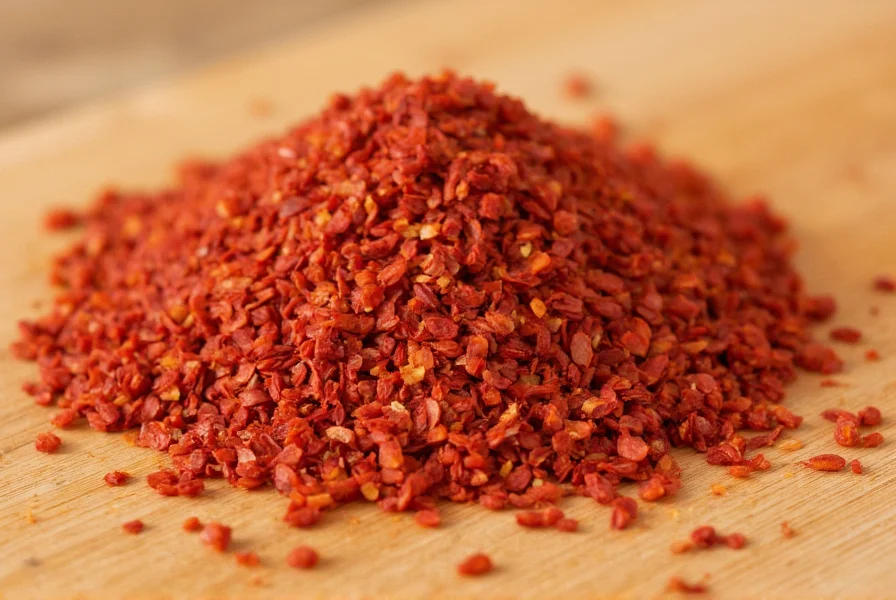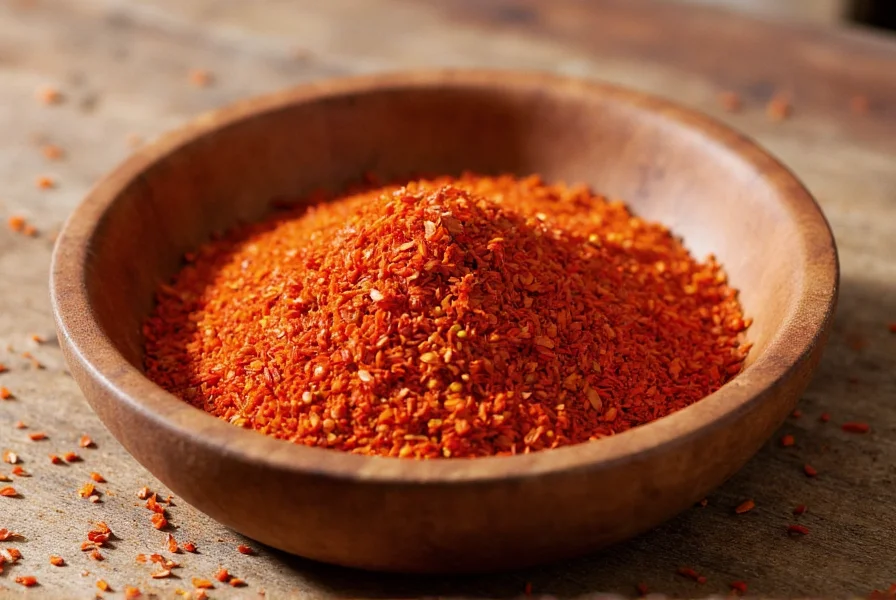Understanding how to properly use red chili flakes can transform your cooking from bland to brilliant. These vibrant crimson fragments deliver more than just heat—they contribute complex flavor dimensions that elevate countless dishes across various cuisines. Let's explore everything you need to know about incorporating this pantry staple effectively.
What Exactly Are Red Chili Flakes?
Red chili flakes consist of dried, broken pieces of moderately hot chili peppers, primarily cayenne varieties but often including others like bird's eye or ancho peppers. The flakes contain a mixture of pepper flesh, seeds, and membranes, which creates their characteristic heat profile. Unlike pure cayenne powder which is uniformly ground, red chili flakes maintain visible texture that adds both visual appeal and controlled heat distribution in dishes.
The production process involves harvesting ripe red peppers, drying them thoroughly (either sun-dried or using dehydrators), then crushing them into small, irregular pieces. Quality red chili flakes should appear uniformly red without dark spots or excessive stem fragments. The best varieties contain a thoughtful blend of pepper types to balance heat with flavor complexity—a crucial consideration when exploring how to use red chili flakes in cooking effectively.

Flavor Profile and Heat Level Explained
Understanding the heat level of red chili flakes helps you use them appropriately in recipes. Most commercial blends measure between 30,000-50,000 Scoville Heat Units (SHU), placing them in the medium-hot range—significantly milder than habaneros (100,000-350,000 SHU) but hotter than jalapeños (2,500-8,000 SHU).
What makes red chili flakes special is their flavor complexity beyond mere heat. They offer:
- Subtle smokiness from the drying process
- Fruity undertones reminiscent of dried tomatoes
- Earthy notes that complement savory dishes
- Variable heat intensity depending on seed content
| Chili Product | Scoville Range | Texture | Best Culinary Uses |
|---|---|---|---|
| Red Chili Flakes | 30,000-50,000 | Crushed pieces | Pasta, pizza, roasted vegetables |
| Cayenne Powder | 30,000-50,000 | Fine powder | Rubs, sauces, baking |
| Crushed Red Pepper | Varies | Mixed textures | General seasoning |
Red Chili Flakes vs Crushed Red Pepper: Understanding the Difference
Many consumers wonder about the distinction between red chili flakes vs crushed red pepper. While often used interchangeably in recipes, there are subtle differences:
True red chili flakes typically contain a single pepper variety (usually cayenne) with consistent heat levels. Crushed red pepper often refers to a blend of various red peppers, potentially creating more complex flavor but less predictable heat. The texture also differs—red chili flakes maintain larger, more uniform pieces while crushed red pepper may contain finer particles.
When following recipes that specify one or the other, consider these nuances. For dishes where visual presentation matters (like finishing a pizza), proper red chili flakes provide more attractive speckling. For applications where complete dissolution is preferred (like in sauces), crushed red pepper might integrate more smoothly.
Mastering Culinary Applications
The versatility of red chili flakes makes them indispensable in many kitchens. Understanding best dishes for red chili flakes ensures you maximize their potential:
When to Add During Cooking
Timing matters significantly when using red chili flakes:
- Early addition (sautéing with aromatics): Releases maximum heat but mellow flavor
- Middle cooking phase: Balances heat integration with flavor preservation
- Finishing touch: Provides vibrant color and immediate heat sensation
For Italian dishes like arrabbiata sauce, adding flakes early creates deep, integrated heat. For pizza or focaccia, finishing with flakes preserves their bright color and sharper heat profile.
Perfect Pairings Across Cuisines
Red chili flakes shine in diverse culinary traditions:
- Italian cuisine: Essential in arrabbiata sauce, perfect with pasta dishes
- Mediterranean dishes: Complements roasted vegetables and olive oil-based sauces
- Asian fusion: Adds dimension to stir-fries when used sparingly
- Baking applications: Surprisingly effective in chocolate desserts for contrast

Optimal Storage and Shelf Life
Proper handling preserves the vibrant flavor of your red chili flakes. Follow these storage tips for red chili flakes to maintain quality:
- Store in airtight containers away from light and moisture
- Keep in a cool, dark cupboard (not above the stove where heat fluctuates)
- Expect peak flavor for 6-12 months; maximum shelf life of 18 months
- Freeze for long-term storage (up to 2 years) in vacuum-sealed bags
Signs your red chili flakes have degraded include faded color (from vibrant red to dull brown), diminished aroma, and loss of heat intensity. Properly stored flakes should retain their characteristic fragrance and deliver consistent heat.
Effective Substitutes When You're Out
Running out of red chili flakes doesn't have to derail your cooking plans. Consider these alternatives when seeking red chili flakes substitutes:
- Crushed red pepper: Nearly identical in most applications
- Cayenne pepper (use 1/3 amount): More intense heat without texture
- Hot paprika (use double amount): Milder heat with similar color
- Fresh red chili peppers (finely minced): Different flavor profile but similar heat
When substituting, remember that powdered alternatives distribute heat more evenly but lack the textural component that makes red chili flakes special. Adjust quantities carefully based on the substitute's heat level.
Crafting Homemade Red Chili Flakes
For superior flavor control, consider making homemade red chili flakes. This process allows you to customize heat levels and flavor profiles:
- Select ripe red chili peppers (cayenne, serrano, or mix)
- Wash and thoroughly dry peppers (air dry or use dehydrator)
- Remove stems but retain some seeds for heat
- Dehydrate at 135°F (57°C) for 8-12 hours until brittle
- Cool completely before crushing by hand or with food processor
- Store in airtight container away from light
Homemade versions typically offer brighter flavor and more controlled heat than commercial products. Experiment with different pepper varieties to create your signature blend—adding a small percentage of sweeter peppers like ancho can balance intense heat with fruitiness.
Frequently Asked Questions
Are red chili flakes the same as crushed red pepper?
While often used interchangeably, there are subtle differences. Red chili flakes typically contain a single pepper variety (usually cayenne) with consistent heat, while crushed red pepper often blends various red peppers creating more complex flavor but less predictable heat. The texture also differs—red chili flakes maintain larger, more uniform pieces while crushed red pepper may contain finer particles.
How much heat do red chili flakes add to dishes?
Most commercial red chili flakes measure between 30,000-50,000 Scoville Heat Units (SHU), placing them in the medium-hot range. This is significantly milder than habaneros (100,000-350,000 SHU) but hotter than jalapeños (2,500-8,000 SHU). The actual heat impact depends on how they're used—adding early in cooking creates deeper, integrated heat while finishing with flakes provides immediate heat sensation.
What's the best way to store red chili flakes for maximum freshness?
Store red chili flakes in airtight containers away from light and moisture in a cool, dark cupboard. Expect peak flavor for 6-12 months with maximum shelf life of 18 months. For extended storage, freeze in vacuum-sealed bags for up to 2 years. Signs of degradation include faded color (from vibrant red to dull brown), diminished aroma, and loss of heat intensity.
Can I make my own red chili flakes at home?
Yes, making homemade red chili flakes gives you superior flavor control. Select ripe red chili peppers, wash and thoroughly dry them, remove stems but retain some seeds, dehydrate at 135°F (57°C) for 8-12 hours until brittle, then crush by hand or with food processor. Homemade versions typically offer brighter flavor and allow customization of heat levels by blending different pepper varieties.
What dishes work best with red chili flakes?
Red chili flakes excel in Italian dishes like arrabbiata sauce and pasta preparations, Mediterranean roasted vegetables and olive oil-based sauces, Asian fusion stir-fries (used sparingly), and surprisingly in chocolate desserts for contrast. Their texture makes them particularly effective as finishing elements on pizza, focaccia, and grilled meats where visual appeal matters.











 浙公网安备
33010002000092号
浙公网安备
33010002000092号 浙B2-20120091-4
浙B2-20120091-4